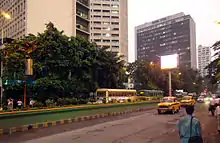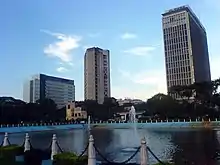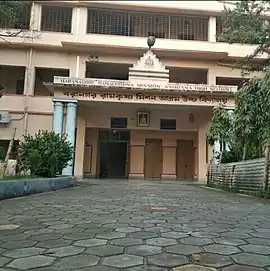Economy of Kolkata
Kolkata is the prime business, commercial and financial hub of eastern India and the main port of communication for the North-East Indian states, It is one of the most important metro cities of India.[1]According to recent estimates of Kolkata's economy is more than $50.447 billion making it third most-productive metropolitan area in India, after Mumbai and Delhi. According to Brookings Institution, Kolkata's GDP on 2020 $50.447 Billion. [2] Kolkata is home to many industrial units operated by large public- and private-sector corporations; major sectors include steel, heavy engineering, mining, minerals, cement, pharmaceuticals, food processing, agriculture, electronics, textiles, and jute. [3] Kolkata is home to India's oldest, and also India's second-largest stock exchange company (bourse)[4] – The Calcutta Stock Exchange. Kolkata is home to a major port, an international airport and many nationally and internationally reputed colleges and institutions aimed at supplying a highly skilled work force.[5] Kolkata is also home to India's and South Asia's first metro railway service – Kolkata Metro.[6]


There are a few of the oldest and front line banks and PSUs —such as UCO Bank, Allahabad Bank, United Bank of India and Geological Survey of India, Zoological Survey of India, Botanical Survey of India and Tea Board of India—were founded and is headquartered in Kolkata. The oldest operating photographic studio in the world, Bourne & Shepherd, is also based in the city. The Standard Chartered Bank has a major branch in Kolkata.[7] Kolkata is also the headquarters of Botanical Survey of India and Zoological Survey of India and many more organisations and companies.
Economic history and recent developments
.jpg.webp)
Kolkata was the capital of the British Indian Empire until 1911. Throughout British Raj, the city was a major port and commerce center in world economy. The Partition of India in 1947 was a major blow to the once flourishing economy during the world wars, it removed most of the hinterland, cutting down the supply of the human resource and a took away a huge portion of its market. Also the huge inflow of refugee from East Pakistan was a major drain to the city's infrastructure which was inadequate for the population boom. In the 1970s, the city saw a predominance of the trade-union movements which led the investors to flow out of the state to other newly emerging destinations in India. As the investors lacked trust in the newly formed communist government, the lack of capital destroyed most of its small-scale industries like foundrys and tool casting. Once India's leading city, Kolkata experienced a steady economic decline in the decades following India's independence due to steep population increases and a rise in militant trade-unionism, which included frequent strikes that were backed by left-wing parties.[8] From the 1960s to the late 1990s, several factories were closed and businesses relocated.[8] The lack of capital and resources added to the depressed state of the city's economy and gave rise to an unwelcome sobriquet: the "dying city".[9]
Since the late 1990s, Kolkata has managed to board the all-India bandwagon of buzzing economic sectors like information technology (IT) and business process outsourcing (BPO), along with a good pace of development matching all India average[10] with the liberalization of the Indian economy. In 2009, Kolkata was ranked the hardest of 17 Indian cities in which to do business by the World Bank.[11]However in 2019, Kolkata, along with Bengaluru was included in the list of cities in India for the World Bank's ease of doing business survey in India, which so far covered only Delhi and Mumbai.[12]
GDP of Kolkata
.jpg.webp)
According to recent estimates of Kolkata's economy is more than $50.447 billion making it third most-productive metropolitan area in India, after Mumbai and Delhi. According to Brookings Institution, Kolkata's GDP on 2020 is $50.447 Billion.[13] However, in 2010, Kolkata, had an estimated Gross domestic product (GDP) of 40 billion dollars, ranked third among South Asian cities, after Mumbai and Delhi.[14] Kolkata's nominal GDP is expected to reach US$60 billion in 2030, with a per capita nominal GDP of US$3,400.[15] In 2015, The Brookings Institution, a U.S. based think tank in collaboration with JPMorgan ranked Kolkata second among all Indian metros and 32nd among 300 major metropolitan economies of the world on overall economic performance for the year 2013-’14. According to this report, With annualised GDP per capita growth of 4.7% and employment growth of 2.5% Kolkata scored over every Indian city, except Delhi.[16][17]
Sectors
Flexible production has been the norm in Kolkata, which has an informal sector that employs more than 40% of the labour force.[18] Over the years, the informal sector has grown in size and as a proportion of the total workforce of the Kolkata metropolitan area.[19] One unorganised group, roadside hawkers, generated business worth ₹ 87.72 billion (US$ 2 billion) in 2005.[20] As of 2001, around 0.81% of the city's workforce was employed in the primary sector (agriculture, forestry, mining, etc.); 15.49% worked in the secondary sector (industrial and manufacturing); and 83.69% worked in the tertiary sector (service industries).[21]:19 As of 2003, the majority of households in slums were engaged in occupations belonging to the informal sector; 36.5% were involved in servicing the urban middle class (as maids, drivers, etc.), and 22.2% were casual labourers.[22]:11 About 34% of the available labour force in Kolkata slums were unemployed.[22]:11 According to one estimate, almost a quarter of the population live on less than 27 rupees (equivalent to 45 US cents) per day.[23] Since 2017, warehousing industry in the vicinity of the city experienced significant increase, and was the fastest growing market in India, per 2019 report.[24][25]
Major Companies based in Kolkata
Kolkata is home to many industrial units operated by large public- and private-sector corporations; major sectors include steel, heavy engineering, mining, minerals, cement, pharmaceuticals, food processing, agriculture, electronics, textiles, and jute.
Companies such as ITC Limited, CESC Limited, Exide Industries, Emami, Eveready Industries India, Lux Industries, Rupa Company, Berger Paints, Birla Corporation, Peerless Group and Britannia Industries, Jai Balaji group, Shyam Steel Industries Limited are all headquartered in the city. Philips India, PricewaterhouseCoopers India, Tata Global Beverages, Tata Steel have their registered office and zonal headquarters in Kolkata. Some of the oldest public sector companies are headquartered in the city such as the Coal India Limited, National Insurance Company, Garden Reach Shipbuilders & Engineers, Tea Board of India, Geological Survey of India, Zoological Survey of India, Botanical Survey of India, Jute Corporation of India, National Test House, Hindustan Copper and the Ordnance Factories Board of the Indian Ministry of Defence, Damodar Valley Corporation and India Govt. Mint are also headquartered in the city. Kolkata hosts the headquarters of three major public-sector banks:Allahabad Bank, UCO Bank, and the United Bank of India and India's one of the newest private bank Bandhan Bank.
Among these three of the Forbes Global 2000 listed companies are headquartered in Kolkata, which includes ITC Limited, Coal India , Allahabad Bank and UCO Bank.[26]
Banking

Kolkata is an important centre for banking. At present, the city serves as the headquarters of large nationalised bank UCO Bank and a private scheduled bank - Bandhan Bank. Several large financial companies and insurance companies are headquartered in Kolkata including Magma Fincorp, Bandhan Bank, SREI Infrastructure Finance, National Insurance Company. Many Indian banks, multi-national banks and the World Bank have located their Branch offices operations in the city. All main banks from India have their branch office here. Also big financial banks like Standard Chartered Bank, Bank of America and HSBC Bank have office and branches in Kolkata. Bandhan Financial, the largest Microfinance Group in India from Kolkata and 2nd largest of its kind in the World has got RBI nod to set up banks all over India. Bandhan Bank has its Head Office in Kolkata, which is the only bank after independence to be established in the city.
Ease of Doing Business in Kolkata
According to a World Bank Ease of Doing Business report in 2009, Kolkata ranked 17 out of 17 cities surveyed in India, while New Delhi was at 10th, and Bengaluru at 16th. In procedure to start a business, Kolkata ranked 10th.[27] Kolkata has a process to obtaining trade license in the city which is unique in India.[28] This ranking however has become better as per recent estimates.Kolkata Municipal Corporation (KMC) is the central authority which deals with the processing of new trade licenses and the renewal[29] of the same as well.In 2019, Kolkata, along with Bengaluru was included in the list of cities in India for the World Bank's ease of doing business survey in India, which so far covered only Delhi and Mumbai.[30]
Gallery
 Unitech InfoSpace Hi-Tech Park (New Town) Kolkata
Unitech InfoSpace Hi-Tech Park (New Town) Kolkata Unitech InfoSpace
Unitech InfoSpace HIDCO Bhawan (Narkel Bagan) New Town Kolkata
HIDCO Bhawan (Narkel Bagan) New Town Kolkata DLF (IBM Pvt. Ltd.) IT Tech Park, New Town, Kolkata
DLF (IBM Pvt. Ltd.) IT Tech Park, New Town, Kolkata Inside Wipro Technologies Saltlake City, Sector V, Kolkata
Inside Wipro Technologies Saltlake City, Sector V, Kolkata Wipro Technologies, Saltlake City, Sector V, Kolkata
Wipro Technologies, Saltlake City, Sector V, Kolkata College More, Saltlake City, Sector V, Kolkata
College More, Saltlake City, Sector V, Kolkata Technopolis, Saltlake City, Kolkata
Technopolis, Saltlake City, Kolkata Saltlake City, Major Economy Towers
Saltlake City, Major Economy Towers Mallikghat flower market
Mallikghat flower market
References
- "Better Integrated Transport Modes will Help Reinvent Kolkata". World Bank. 20 April 2016. Archived from the original on 27 March 2019. Retrieved 9 February 2020.
- "Top 10 richest cities in India in 2020". India Today. Retrieved 20 January 2021.
- https://timesofindia.indiatimes.com/city/kolkata/kolkata-has-9600-millionaires-60-billion-in-total-wealth/articleshow/57285430.cms
- CSE Factbook. Calcutta Stock Exchange Association Ltd.
- Dasgupta, 2002
- "Metro Railway, Kolkata". Archived from the original on 20 August 2007. Retrieved 2007-09-01.
- "Standard Chartered Bank website". Archived from the original on 22 March 2006. Retrieved 28 March 2006.
- Dutta, Tanya (22 March 2006). "Rising Kolkata's winners and losers". BBC. Archived from the original on 4 February 2012. Retrieved 11 December 2011.
- Dutta, Sudipta (1 February 2009). "Calcutta chronicles". Financial Express. New Delhi. Archived from the original on 15 June 2013. Retrieved 6 December 2011.
- "Modi's Surat tops GDP race at 11.5%". The Times of India. 28 January 2008.
- "Doing Business in India 2009" (PDF). World Bank. Retrieved 8 June 2010.
- https://www.livemint.com/news/india/wb-s-ease-of-doing-business-survey-to-also-cover-kolkata-bengaluru-next-year-11571918678598.html
- http://www.ukmediacentre.pwc.com/imagelibrary/downloadMedia.ashx?MediaDetailsID=1562. Archived from the original on 31 May 2013. Missing or empty
|title=(help) - "GDP: The top 10 cities in India". rediff.com. 23 April 2010. Retrieved 3 March 2012.
- "Kolkata". INDIA BRIEFING. Retrieved 23 June 2016.
- "Global Metro Monitor:2014". The Brookings Institution. Retrieved 24 June 2016.
- "Is West Bengal's economy actually reviving under Mamata Banerjee?". Scroll. Retrieved 23 June 2016.
- Chakravorty, Sanjoy (2000). "From colonial city to global city? The far-from-complete spatial transformation of Calcutta". In Marcuse, Peter; Kempen, Ronald van (eds.). Globalizing cities: a new spatial order?. Oxford, UK: Blackwell Publishing. pp. 56–77. ISBN 978-0-631-21290-4.
- Shaw, Annapurna (2016). "The Informal Sector in Kolkata Metropolitan Area: Appraisal and Prospects for Local Economic Development". Spatial Diversity and Dynamics in Resources and Urban Development. Dordrecht: Springer Netherlands. pp. 499–516. doi:10.1007/978-94-017-9786-3_24. ISBN 978-94-017-9785-6.
- Ganguly, Deepankar (30 November 2006). "Hawkers stay as Rs. 265 crore talks". The Telegraph. Kolkata. Archived from the original on 27 September 2007. Retrieved 16 February 2008.
- Sahdev, Shashi; Verma, Nilima, eds. (2008). "Urban Land price Scenario- Kolkata − 2008" (DOC). Kolkata—an outline. Industry and Economic Planning. Town and Country Planning Organisation, Ministry of Urban Development, Government of India.
- Kundu, N. "Understanding slums: case studies for the global report on human settlements 2003. The case of Kolkata, India" (PDF). Development Planning Unit. University College, London. Archived (PDF) from the original on 24 May 2006. Retrieved 26 April 2006.
- "End is nigh for Gandhis after India's marathon poll". The Times. 12 January 2014. Archived from the original on 12 May 2014. Retrieved 12 May 2014.
- "Kolkata tops in warehousing leasing volume, says report". Financial Express. 20 June 2019. Retrieved 19 January 2020.
- Law, Abhishek (30 July 2019). "Kolkata is a top warehousing hub now". The Hindu Business Line. Retrieved 19 January 2020.
- "The Global 2000". Forbes. 8 April 2009.
- "Ease of Doing Business in Kolkata - India". doingbuisness.org. World Bank Group. Retrieved 7 October 2015.
- Dikshit, Dhruv (18 September 2015). "How to obtain a trade license in Kolkata". iPleaders. iPleaders. Retrieved 7 October 2015.
- "Official Website of Kolkata Municipal Corporation". www.kmcgov.in. Retrieved 8 October 2015.
- https://www.livemint.com/news/india/wb-s-ease-of-doing-business-survey-to-also-cover-kolkata-bengaluru-next-year-11571918678598.html
